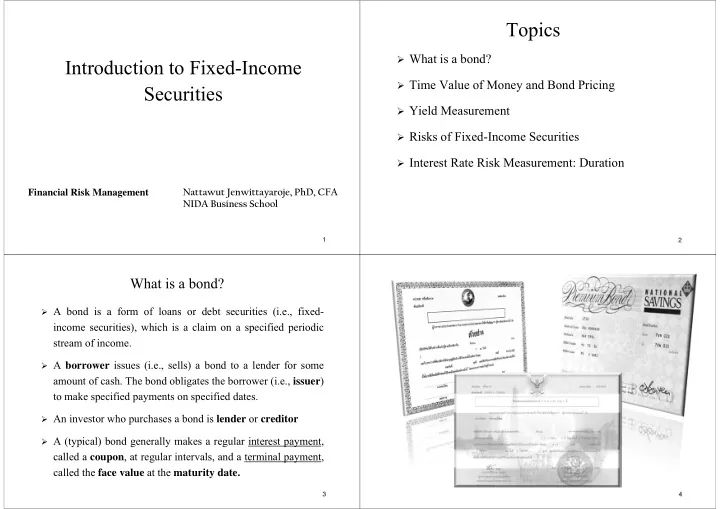

Topics What is a bond? Introduction to Fixed-Income Time Value of Money and Bond Pricing Securities Yield Measurement Risks of Fixed-Income Securities Interest Rate Risk Measurement: Duration Nattawut Jenwittayaroje, PhD, CFA Financial Risk Management NIDA Business School 1 2 What is a bond? A bond is a form of loans or debt securities (i.e., fixed- income securities), which is a claim on a specified periodic stream of income. A borrower issues (i.e., sells) a bond to a lender for some amount of cash. The bond obligates the borrower (i.e., issuer ) to make specified payments on specified dates. An investor who purchases a bond is lender or creditor A (typical) bond generally makes a regular interest payment, called a coupon , at regular intervals, and a terminal payment, called the face value at the maturity date. 3 4
What is a bond? Example 1: Illustrate a cash flow stream of a 3-year bond with a $80 coupon (8% coupon rate), and a face value of $1,000. In general, the bond must specify its Coupons are paid annually. Issuer (the borrower) Face value or par value (principal of the loan) Borrowing $1,000 for 3 years Borrower issues the bond • Face value is the amount that is to be paid to an investor at the maturity to a buyer for $1,000 date of the security. End of year Maturity date and term-to-maturity Today year 1 year2 year 3 • The final coupon and the face value of a bond are repaid to the investor on its maturity date. Coupon rate (per annum) Price = (-)$1,000 $80 $80 $80+1,000 • used to calculate a coupon payment, or interest payment, paid at regular intervals by the issuer to bondholders. Investors buy the bond today, and Lending $1,000 for 3 years Frequency of coupon payments is entitled to a payment of $80 per • Usually are semi-annually, annually or quarterly. year for 3 years and par value of $1,000 at the end of year 3 5 6 Example 2: illustrate a zero-coupon bond that makes no coupon payments. Investors receive par value (e.g., $1,000) at the maturity (e.g., 4 years) but receive no interest payments. The zero-coupon bond are issued at prices considerably below par value, e.g., $750. Time Value of Money Borrowing $1,000 for 4 years Borrower issues the bond to a buyer for $750 and Bond Pricing End of year Today year 1 year2 year 3 year 4 Price = (-)$750 $0 $0 $0 $1,000 Investors buy the bond today, and Lending $1,000 for 4 years is entitled to a par value of $1,000 at the end of year 4 7 8
มูลค่าอนาคต (Future Value) และ มูลค่าปัจจุบัน (Present Value) มูลค่าปัจจุบัน (Present Value ) ของ Ordinary Annuity มูลค่าอนาคต ผู้ลงทุนต้องการซื้อเครื่องมือทางการเงิน ที่จ่ายเงินสด $500 ต่อปีเป็น เช่น ฝากเงินวันนี้ = 100 บาท ที่ อัตราดอกเบี้ย ( อัตราผลตอบแทน ) 5% ต่อปี จํานวนหนึ่งและสองปี FV หรือ มูลค่าของเงิน 100 บาท ในหนึ่งและสองปีข้างหน้า เวลา 20 ปี โดยเริ่มจ่าย 1 ปี ต่อจากวันนี้ หนึ่งปีข้างหน้า ผู้ลงทุนต้องการอัตราดอกเบี้ย ( ผลตอบแทน / อัตราคิดลด ) ต่อปีที่ 5.5% สองปีข้างหน้า จากการลงทุนดังกล่าว มูลค่าปัจจุบัน ถ้าราคาเครื่องมือทางการเงินดังกล่าวซื้อขายกันที่ $5,300. i นั้นคือ อัตราดอกเบี้ย ต่องวด หรือ อัตราคิดลด (discount rate). ผู้ลงทุนควรจะซื้อเครื่องมือทางการเงินดังกล่าวหรือไม่ PV บางครั้งเรียกว่า มูลค่าคิดลด (discounted value) หรือ มูลค่าของเงินรวมในอนาคตที่คิดกลับมา ที่จุดเริ่มต้น หรือ มูลค่าปัจจุบัน PV ( มูลค่าปัจจุบัน ) ของเงิน 100 บาทในสองปีข้างหน้า ที่ discount rate ที่ 4% 9 10 มูลค่าปัจจุบัน (Present Value ) ของ Ordinary Annuity ตัวอย่าง : มูลค่าปัจจุบันของ Ordinary Annuity ณ ปลายปี มูลค่าในปัจจุบันของเงินที่เกิดขึ้นทุกสิ้นงวด อธิบายเป็นสูตรได้ดังนี้ 0 1 2 3…..…10…….20 $500 A = เงินงวดเป็นจํานวนเงินคงที่เท่ากันทุกงวด $500 i = อัตราดอกเบี้ยทบต้น $500 n = จํานวนงวดของกระแสเงินสด $500 ซื้อ $500 ผลรวมทั้งหมดของค่า PV = $5,975.19 11 12
As can be seen in [1], the price of a bond is comprised of Bond Pricing the PV of a series of the coupon payments The price paid for a bond today depends on the value of dollars to be received in the future under the bond indenture. the PV of the face value. Annuity Factor ( i,n ) The fair price of a bond is the present value of future cash flows (coupons and The coupon payments are equivalent to an ordinary annuity . face value) that it makes. [1] If the coupon payments are made more than one time per year. PB = price of bond where n = number of periods to maturity C = coupon payment ($) = i = periodic interest rate n = number of years to maturity i = discount rate (i.e., required yield = ผลตอบแทนที่ต้องการ ) C = F = face value 13 14 Bond Pricing (Con’t) Bond Pricing (Con’t) Example 3: Mills Company, a large defense contractor, on January 1, 2007, issued a 10% coupon interest rate, 10-year bond with a $1,000 par value that pays interest annually. Investors who buy this bond receive the contractual right to receive two cash flows: (1) $100 annual interest (10% coupon interest rate $1,000 par value) at the end of each year, and (2) the $1,000 par value at the end of the tenth year. Let’s assume the required yield is 10%. C = $100, i = 10%, F = $1,000, and n = 10 years. P 15 16
Bond Pricing (Con’t) Bond Values and Required Returns Calculate the price of a 10% coupon bond with 10 years to maturity and a face value of i P $1,000. The coupon payments are made annually, and the required yield is 12% per annum. Calculate the price of the Negative relationship between price of a bond and its yield. bond in previous example, As the required yield increases, the PV of the cash flows must decrease; but with the required yield therefore, the price decreases. of 8% per annum. As the required yield decreases, the PV of the cash flows must increase; therefore, the price increase. 17 18 Price/yield relationship ( ความสัมพันธ์ของราคากับอัตราดอกเบี้ย ) Bond Values and Required Returns ราคาของตราสารหนี้แปรผกผันกับอัตราผลตอบแทนที่นักลงทุนต้องการ (required yield; y) ในขณะที่ อัตราผลตอบแทนที่นักลงทุนต้องการแปรผันไป ตามอัตราดอกเบี้ยตลาด (interest rate; i) interest rates Required yield P interest rates Required yield ดังนั้น ราคา ของตราสารหนี้ แปรผกผัน กับ อัตราดอกเบี้ยตลาด (interest rate; i) i 19 6-19 20
Recommend
More recommend